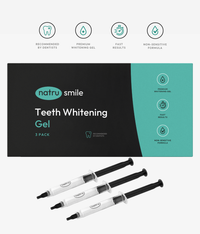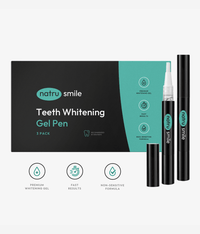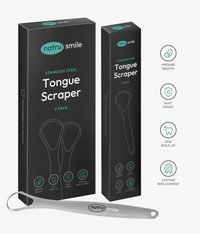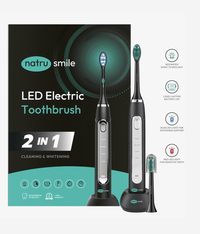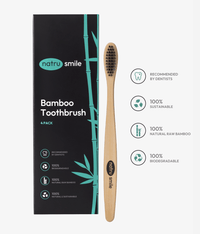
All products are certified by dental expert Dr. Greg Grillo
Crossbite is one of the most commonly seen orthodontic issues. Usually, it is just like any other misalignment, but it can sometimes significantly impact your overall dental health if left untreated.
We'll go over all of the basics here—including definition, pictures, causes, and treatment—so that you can get a better understanding of this issue and how it can be addressed.
What Is A Crossbite? A Quick Look
Crossbite is a malocclusion (i.e., a misalignment of the bite) in which the upper teeth and lower teeth do not align properly. This can happen when one or more of the upper teeth are positioned too far inside, while one or more of the lower teeth are too close to the outside. Here's what this might look like:
In a healthy bite, the upper teeth sit outside the lower teeth, creating a slight overlap. When a patient has a crossbite, some of the lower teeth sit outside the upper teeth or vice versa, causing the opposite pattern. This misalignment can occur in different parts of the mouth—the front teeth, back teeth, or both.
According to the American Association of Orthodontics, crossbite is one of the most common dental problems. It is usually hereditary (i.e., passed down from a parent), but can also be caused by trauma or bad habits during childhood or infancy, such as thumb-sucking.
Crossbite can cause discomfort and pain and affect your overall dental health, making prompt and proper treatment an essential first step.
Two General Types Of Crossbite
There are two different types of crossbite, but they both share the same fundamental problem: a misaligned bite.
Let's take a look at each in more detail.
Posterior Crossbite
Posterior crossbite is the most common type of crossbite, occurring when one or more of the back teeth bite outside of their corresponding upper teeth. It affects up to 17% of children and adolescents, according to comprehensive research.
Common issues posterior crossbite causes include:
- Uneven wear of the tooth surfaces, leading to premature damage and destruction of teeth
- Dental crowding or misalignment of the jaw
- Jaw pain due to abnormal muscle function
With posterior crossbite, the main problem is the back teeth, so treatment usually includes wearing an appliance (e.g., a retainer or headgear) to gradually move the back teeth into proper alignment.
Anterior Crossbite
Anterior crossbite is still relatively common in the world of orthodontics, and it occurs when one or more of the front teeth bite outside their corresponding upper teeth.
Like posterior crossbite, anterior crossbite can cause a number of issues, such as uneven tooth wear, dental misalignment, and jaw pain. The treatment is similar to that of posterior crossbite in that it involves wearing an appliance (e.g., braces or a retainer) to gradually reposition the teeth in their correct alignment.
Sometimes, jaw surgery is necessary if the misalignment is severe enough and cannot be corrected with an appliance alone.
Pictures Of Posterior And Anterior Crossbites
Anterior crossbite
Severe anterior crossbite
Posterior crossbite
Severe posterior crossbite
Common Crossbite Causes
Like many malocclusions, whether or not someone develops a crossbite might be completely out of their control. Other times, it is the direct result of bad habits or trauma.
Here are the most common causes of crossbite:
1. Circumstantial Factors
Circumstantial factors like jaw size and shape, tongue size, and tooth size can all be factors in whether or not someone develops a crossbite.
These hereditary factors might be obvious from an early age (e.g., a child with a noticeably larger lower jaw). In other cases, they won't show themselves until later in their childhood development.
In either instance, they are out of the patient's control. For example, a lack of alignment in the jaw area will force functional teeth to overlap over the course of a child's growth. As their teeth grow in, they will be forced into an irregular pattern due to the immovable nature of the jaw.
2. Genetics
As we mentioned, the vast majority of dental misalignment issues are hereditary. Beyond facial structure and circumstantial factors, there are other ways genetics can come into play.
Studies have identified several genes associated with malocclusions, which can increase the risk of developing crossbite and other types of dental misalignment.
For example, a study published in the International Journal of Molecular Sciences found that variations in the IRF6 gene, which is involved in the development of the lip and palate, were associated with an increased risk of developing malocclusions, including crossbite.
3. Tongue Thrust
Tongue thrust (medically referred to as "orofacial myofunctional disorder" or "OMD") is a condition where a person pushes their tongue against the front teeth while speaking, swallowing, or chewing. This can force the back teeth out of alignment and lead to an anterior or posterior crossbite.
Tongue thrust is also a well-known cause of buck teeth—another form of misalignment—so it is important to address if you think your child might be suffering from this issue.
This behavior isn't done intentionally, and is usually caused by a lingering childhood habit (e.g., sucking on the thumb or finger) that wasn't corrected. In some cases, it can be treated with behavioral therapy to retrain the tongue muscles.
4. Missing Teeth
In some cases, all 32 teeth may not be present when the permanent teeth start coming in. This often leads to overcrowding or improper alignment because they don't have enough space to fit properly.
In some cases, missing teeth can also lead to a crossbite as the other teeth shift into the vacant spaces. The best way to address this issue is with dental implants or bridges, which can help fill in the gap and restore proper alignment.
5. Trauma
Trauma, such as a knock to the face or jaw, can damage certain teeth and cause them to come out of alignment. If a tooth is severely damaged and needs to be removed, the other surrounding teeth may start overlapping into its place. This creates a crossbite and can lead to other issues if not addressed quickly.
Blunt force can also cause your jaw to become permanently misaligned, leading to a crossbite years later.
6. Baby Teeth That Don’t Fall Out
When baby teeth do not fall out in a timely manner, they can interfere with the eruption of permanent teeth, leading to dental misalignments like crossbite.
In some cases, baby teeth may need to be extracted to allow permanent teeth to come in properly.
7. A Small Jaw That Can’t Fit All Your Teeth
When the jaw is too small to accommodate all the teeth, the teeth can become crowded, causing misalignments like crossbiting. This can occur due to genetic factors or environmental factors like poor nutrition or oral habits that affect jaw growth. Braces and expanders can help widen the jaw and create more space for the teeth to fit properly.
8. Teeth Too Big For Proper Alignment
As children lose their baby teeth, the new teeth that take their place can be larger than what the jaw can accommodate. This can lead to crowding and overlapping, resulting in a crossbite.
Corrective measures like braces or expanders may be needed to help make room for these teeth so they can fit properly within the jaws. In extreme cases, they may need to be pulled and replaced with implants.
9. Cleft Lip Or Palate
Cleft lip or palate (commonly referred to as "CL/P") is a condition where the lip and/or roof of the mouth does not form correctly due to genetic or environmental factors.
This can lead to an improper bite, as the jaw may not be able to close properly. This often leads to a crossbite if left untreated.
Surgery can help repair the cleft and improve the alignment of the teeth and jaw, reducing or eliminating the crossbite.
10. Mouth Breathing
Mouth breathing is a common condition where the person breathes through their mouth instead of their nose. This can cause the jaw to become misaligned and lead to a crossbite if left untreated.
Mouth breathing can be caused by allergies, sinus problems, or other conditions that affect the nasal passages. Treating these underlying issues is often necessary in order to ensure long-term benefits for your bite, and patients will have to take care of that during their orthodontic treatment.
Signs And Symptoms Of Crossbite In Adults
Although children primarily develop crossbites, adults can also experience this issue. A crossbite in adults can lead to tooth decay, gum disease, or jaw pain if left untreated. Common signs and symptoms of adult crossbite include:
- Teeth that overlap or appear crooked
- Difficulty chewing or talking
- Jaw pain or discomfort
- Uneven wear on the teeth
- Tooth sensitivity
When an adult develops crossbite, it's usually the result of a chronic habit like bruxism or a traumatic event that caused misalignment. As we get older, our teeth can also shift due to age-related changes in the jawbone.
No matter what the cause, it's important to see a dentist if you think you have crossbite so they can provide treatment and help protect your oral health.
Ways To Fix Crossbite Teeth
Just like an overbite or an underbite, crossbites can be corrected with orthodontic treatments like braces or aligners. However, the exact treatment will depend on the severity and cause of your bite issue. Your dentist or orthodontist may recommend one or more of the following treatments:
Braces
Wearing braces is the most common solution for patients with a crossbite. Almost half of the population needs braces, and they are used to treat everything from mild to severe bite issues. Braces use brackets and wires to gently move the teeth into the correct position over time.
If you need to wear braces, the orthodontist will typically recommend a customized treatment plan that includes regularly scheduled visits and adjustments over the course of several months or years.
Palatal Expanders
A palatal expander, also known as a rapid maxillary expander (RME), is a device that’s used to widen the upper jaw. It consists of a metal plate with screws on the outside that gradually widen the plate as it is turned, which increases the width of the arch. Expanders are commonly used for crossbites that result from a narrow upper jaw.
Retainers
Once your teeth have been realigned with braces or expanders, you'll need to wear a teeth retainer to keep them in place.
Retainers are a standard part of orthodontic treatment and usually need to be worn for at least a few months after the braces are removed. If they aren't worn enough, a crossbite may develop again as the teeth become misaligned over time.
Elastics (Prescribed By Orthodontist)
In serious cases of crossbite, the orthodontist may prescribe elastics to help move the teeth into the correct position. Elastics are rubber bands that attach to brackets on the top and bottom canine teeth, and they put pressure on both arches so that the upper and lower teeth fit together correctly.
They can be uncomfortable at first, but they're an effective way to realign the teeth and correct an overbite or crossbite.
Clear Aligners
When it comes time to start your braces treatment, you will have the option of either Invisalign or metal braces. Invisalign (clear aligners) are becoming increasingly popular due to their convenience, comfort, and effectiveness.
Invisalign uses a series of clear plastic trays that fit over the teeth and gradually shift them into the correct position. Treatment typically takes about 6-12 months, depending on the severity of your crossbite.
Fixed Palatal Crib
Fixed palatal cribs are a type of orthodontic appliance that includes metal bands and wires that are attached to the upper molars. Cribs are usually used in conjunction with braces or aligners to pull the teeth into better alignment.
This treatment option is commonly used for adults with serious crossbite issues that other treatments cannot resolve.
Myofunctional Therapy
If a patient's crossbite is the result of a myofunctional issue like tongue thrusting, myofunctional therapy may be recommended. This type of treatment includes exercises that help to retrain the muscles in the face and mouth to reduce bad habits like thumb sucking or tongue thrusting.
Cost Of Crossbite Treatment
The cost of a crossbite treatment is closely tied to the cost of braces, which will likely be the main part of the treatment plan. It also depends on how severe the crossbite is and whether the patient requires medical intervention (i.e., surgery or therapy) in addition to the braces.
In general, the average cost of crossbite treatment is between $3,000 and $7,000, although this can vary greatly depending on the individual’s needs.
If a patient requires jaw surgery, the cost could total over $20,000. And therapy sessions and ongoing maintenance could cost hundreds of dollars per visit.
It's important to keep in mind that orthodontic treatment is an investment in your long-term dental health and it’s worth the cost for a lifetime of healthy, beautiful smiles.
Do You Really Need To Correct A Crossbite?
If you have a crossbite, your dentist will always recommend corrective action. Ultimately, it is up to you to decide whether or not to pursue treatment.
If the crossbite is extremely mild and doesn't affect your dental health or oral function, you may decide not to have it corrected. But very few patients have a crossbite that is truly not noticeable.
In most cases, untreated crossbite is severe enough to cause long-term issues like gum disease or tooth decay. And if your jaw or mouth function is compromised even a little bit, it can lead to speech difficulties, TMJ disorders, and other negative consequences.
It's important to consider the consequences of leaving a crossbite untreated before making a decision about whether or not to pursue treatment.
Ultimately, ignoring your crossbite will result in higher costs and more invasive treatment later, so it’s important to consult with your dentist about the best treatment solution for you.
Summary
Crossbite is a common oral health issue that can lead to long-term dental problems if it goes untreated. The most common treatment options include braces, Invisalign, and teeth retainers for post-treatment maintenance. Surgery and myofunctional therapy are also available, depending on the severity of your crossbite.
Although your individual prognosis is inherently unpredictable, the most critical step is the first one: recognizing the need for treatment and then making a plan to correct it.
Want to learn more? Here are the questions our customers ask us the most.
Can Invisalign Fix Crossbite?
Invisalign is a popular orthodontic treatment option that can effectively correct some types of crossbites. Invisalign aligners are customized to fit the patient's teeth and can be removed for eating, brushing, and flossing. Not all crossbites can be corrected with Invisalign, though. Traditional braces may be necessary for the most severe cases. Your orthodontist can evaluate your specific case and recommend the best treatment option for you.
How Long Does It Take To Fix A Crossbite With Invisalign?
The length of time it takes to fix a crossbite with Invisalign can vary depending on the severity of the misalignment and the individual patient's needs. Some patients may see results in as little as six months, while others may require treatment for a year or longer. It's important to follow your orthodontist's instructions for wearing the aligners as directed and attending regular check-ups to monitor progress.
Why Is Crossbite A Problem?
Crossbite causes functional and aesthetic problems in the oral cavity. It can affect the way you bite, chew, and speak, causing discomfort, pain, and difficulty eating or communicating. It can also affect the appearance of your smile and facial structure. Over time, untreated crossbite can lead to further dental complications, including tooth wear, gum disease, and even jaw problems.
Can Crossbite Correct Itself?
Like all other malocculsions, crossbite cannot correct itself. Without proper treatment, the misalignment can worsen over time and cause further complications. Early intervention is key to correcting crossbite and preventing more severe dental issues.
Can A Crossbite Get Worse With Age?
Yes, a crossbite can get worse with age if left untreated. Over time, the misalignment can cause further dental issues, including tooth wear, gum disease, and jaw problems. Early treatment can help prevent these issues and improve overall dental health.
What Is The Fastest Way To Correct Crossbite?
Braces and orthodontic treatment are often the fastest and most effective ways to correct crossbites. The exact length of treatment time will depend on the severity of the misalignment, but many patients can see significant improvement in a matter of months. Your orthodontist can recommend the best treatment options for your specific case and give you an estimated timeline for your treatment.
What Is The Best Age To Fix A Crossbite?
The best age to fix a crossbite is typically as soon as possible, while the jaw is still growing and developing. Most orthodontic treatments for crossbite are performed on children and teenagers, but adults can also benefit from treatment.
Early intervention can help to prevent more severe misalignments and reduce the need for more invasive treatments later in life.
Does Fixing A Crossbite Change Your Face?
Fixing a crossbite can affect the appearance of your face, especially if the crossbite has caused significant asymmetry or affected the alignment of the jaw.
However, the exact changes will vary depending on the individual case and the specific treatment used. In many cases, correcting a crossbite can improve the overall aesthetics of the face and smile.
Does Crossbite Affect Speech?
Crossbite can sometimes affect speech, especially if the misalignment affects the tongue's position and the ability to form certain sounds. If this is the case, treatment for crossbite can help to improve speech and communication abilities.
Does Crossbite Cause Asymmetry?
Yes, crossbite can cause asymmetry in an individual's face, smile, and jaw structure. However, the degree of asymmetry will depend on the severity and location of the crossbite. In minor cases, crossbite may not always be visible.
Is Crossbite A Jaw Problem?
Crossbite can be a jaw problem, as it often involves misaligning the upper and lower jaws. However, the exact cause of the crossbite may vary depending on individual factors such as genetics, tooth size, and environmental factors. An orthodontist can diagnose and recommend the best treatment for crossbite and related jaw problems.
Can Crossbites Be Fixed In Adults?
Yes, crossbites can be fixed in adults, although the treatment process may take longer and require more complex orthodontic appliances than in children. In some cases, adults may also require additional dental procedures, such as tooth extraction or surgery, to correct the misalignment. It's never too late to seek treatment for crossbite, and an orthodontist can assess your specific case and recommend the best treatment options for you.
Does Crossbite Get Worse?
Yes, crossbites can get worse over time if left untreated. Without proper intervention, the misalignment can lead to further dental and jaw problems, including tooth wear, gum disease, and even temporomandibular joint (TMJ) disorders. Seeking early treatment can help to prevent these issues and restore proper dental function and aesthetics.
Are Crossbites Common?
Crossbites are common dental misalignments, although the exact prevalence may vary depending on the population and criteria used to diagnose and classify the crossbite. In general, crossbite is more common among children and adolescents, although it can affect adults as well. If you think you may have a crossbite, talk to your orthodontist for an evaluation and treatment plan.
Can Crossbite Cause Headaches?
Yes, crossbite can cause headaches, particularly if the misalignment affects the position of the jaw and the way it opens and closes. The resulting strain on the muscles and joints of the jaw can lead to pain and discomfort, which can radiate to other areas of the head and face. Treating the underlying cause of the crossbite can help to alleviate these symptoms and improve overall dental health.
Can Crossbite Cause Sleep Apnea?
Crossbite may contribute to sleep apnea by affecting the position of the jaw and tongue, which can obstruct the airway during sleep. However, the exact relationship between crossbite and sleep apnea is complex, and other factors such as weight, age, and medical history can also contribute to the development of sleep apnea.
When Does Crossbite Occur?
Crossbite can occur at any age, but it often develops during childhood when the jaw and teeth are still growing and developing. Factors such as genetics, habits like thumb-sucking, and environmental factors like nutrition can all contribute to the development of crossbite.


